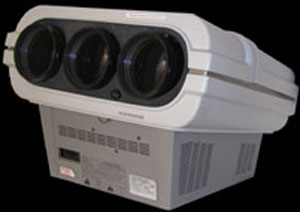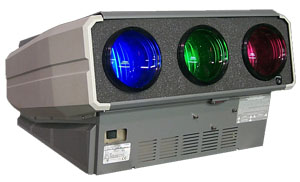 |
CRT Primer
|
Updated: April 2006 |
Electrohome
Electrohome is a Canadian based company
and made two series of projectors
(excluding the very early models), the ECP and Marquee lines.
Electrohome ECP Series
The ECP line came out in about 1984
starting with the ECP 2000. This was a
32 Khz RGB projector only using an older
style of Sony ES focus tube, and had a
large optical system within the
projector that combined the light output
of all three tubes and projected to one
large lens. Apparently there was a video
input board available for the ECP 2000,
but I have never seen one. This model is
now considered obsolete, but complete
working units can be found on
eBay if
you’re looking for spare parts. if
you’re looking for spare parts.
After the ECP 2000 came the ECP 3000 and
4000. In fact, every model from the ECP
3000 and up is very similar, with
circuit and specification changes
differing somewhat. The basic look of
all of these is the same.
The 3000 and 4000 used Sony SD-187
tubes, the same found in a number of
Sony and Barco sets. ES focus, they were
called 7” tubes and have a 5.5” usable
phosphor area. The 3000 scanned to 55
Khz, the 4000 to 80 Khz. Both have
digital convergence and were relatively
easy to set up. Many of the components
were on PC board modules, making field
service simple. The ECP series is taller
than most projectors, making ceiling
installation difficult if the room does
not have a lot of height to it. The ECP
3000 and 4000 were made from around
1988-1990.

Electrohome ECP-4100
The ECP 3100 and 4100 were made from
around 1991-1994. These sets improved on
the convergence software, and other PC
board changes were made, Some boards are
interchangeable throughout the ECP line,
others are model specific.
The ECP 3500 and 4500 used brighter and
newer Sony 07MS tubes for an extra 100
lumens brightness along with sharper
focus. The focus boards that were
notorious for drifting in the earlier
ECP’s were completely redesigned
(although it is a simple task to repair
and modify the older boards), the 3500’s
and 4500’s were made from about 1994 to
1997. These sets are still very popular
and command a good resale value on the
used market.
Electrohome ECP Strength and weaknesses.
The ECP’s have had
numerous problems with them, most of which are inexpensive to repair, but cause
annoying downtime. These include: bad Dallas chips (the main memory of the
entire projector) which should be replaced every 8 years or so, bad focus
resistors in the earlier ECP’s, bad IC connections in their sockets and bad LV
and HV power supplies.
The only real concern are the failure of the power supplies, which while
rare, cannot generally be easily repaired as Electrohome subcontracted the
supplies, and does not provide individual parts or circuit diagrams for them.
When they fail, they must generally be replaced as an entire assembly. ECP’s are
plentiful though, and some power supplies can be interchanged between models.
The ECP 3000 and 4000 are now about 12-13 years old, and are becoming
unreliable with the above described problems. The later models are still a good
bet as a small data grade projector.
Electrohome Marquee Series

Electrohome Marquee 8000
Electrohome is still making their
Marquee series of projectors. These came
out in 1993 as a high end 8 and 9” 1000
lumen EM focus projector. All have
digital convergence, on screen menus,
and work exceptionally well. The M8XXX series designates the 8” model,
the M9XXX the 9” model.
The M8000 came out in 1993, and
was made through to 1995. It was rated
at 1000 lumens due to the slightly lower
voltage high voltage power supply. Sets
pre-May 1994 did not have an internal
hour meter, software changes post June
1994 put one into the service menu.
The M8110, M8500, and M8500LC replaced the 8000 in spring of 1995. The light output was upped to
1200 lumens due to the new high voltage power supply, the tubes, lenses and rest
of the chassis was upgraded some over the M8000 model, but a number of modules
could be interchanged between all of the M8XXX and M9XXX series sets.
The M8500 and M8500LC are the top of the line sets which is identical to the
M8110, but with
the addition of the astigmatism (stigmator) circuits that gave additional beam
focusing capabilities, especially in the corners of the image. While an M8110 can
be turned into an M8500 by adding the missing astig components, they are very
hard to find on the surplus market. The M8500LC is a liquid coupled
version of the M8500.
For video use only, the M8000 and M8110 give an excellent image that comes very
close to the M8500. If you plan on surfing the net or looking at small type or
print on the projector, then the extra charge for the astig circuits in an M8500
is well worth the expense.

Electrohome Marquee 9500LC
The M9000 was released in 1993 and used
9” liquid coupled tubes. These sets
provided better resolution than the
M8000. In 1995 the M9000 was replaced by
the M9500LC. The M9500LC is the
flagship model in the Marquee line,
retailing for over $40K USD when new
These sets are used as the industry
standard for very high end flight
simulators. Modular construction is used
throughout the set for simple field
service for most failures. The older
M9000 model is very similar in
performance to the later M9500LC, and
should not be ruled out as a high end
projector. The exception is the very
early production run of the M9000 that
used Thomson tubes instead of the more
popular MEC tubes. That early model had
issues, and should be avoided.
In 1998, an 'Ultra' designation
appeared, which added additional
features and refined geometry controls.
The M8110+, M8500 Ultra, M8500LC Ultra,
M9500LC Ultra and a few other special
simulator models are built today by VDC
in Florida, as they acquired the Marquee
program from Christie Digital around
November 2001.
The LC (liquid coupled) models in the Marquee series
provide improve contrast ratios and less
halo'ing. These sets are
hard to find, and go for a premium
price, even with worn out tubes.
Electrohome Marquee Strength and weaknesses.
Similar to the ECP’s, the Marquees have the odd power supply failure, and the
high voltage power supply is a sealed unit which cannot be repaired unless
you’re really lucky. These supplies are in demand, as many people want to stock
a spare in case of a failure. Again, they do not fail often, and overall the
Marquees have been reliable. Some of the 8500’s had a power supply design flaw,
which would destroy tubes by supplying them with too much voltage. It’s best to
check if an 8500 that you are considering has been modified to repair this
design flaw.
|
|




